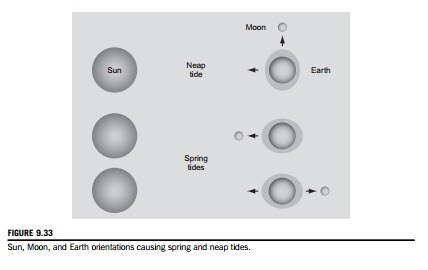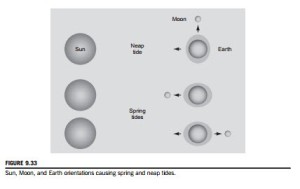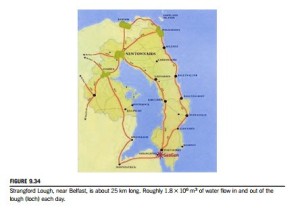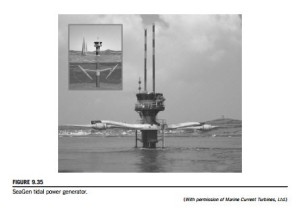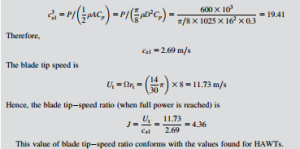Tidal power
Tidal energy is generated by the relative motion of the Earth, Sun, and Moon system whose gravitational forces cause periodic changes to the water levels on the Earth’s surface. The magnitude of the tide at any given location is the result of the varying positions of the Moon and Sun relative to that of the Earth, the rotation of the Earth, the shape of the seabed, and the magnifying effects of the coast. The Moon is the main cause of these tides and the Sun to a much lesser extent. When the Sun and Moon are in-line with the Earth (Figure 9.33), the gravitational force is greatest causing bigger tides (so-called spring tides).
With the Sun and Moon disposed at 90o to the Earth, the gravitational pull on the Earth is weakest (the so-called neap tide). It is worth noting that tidal power is inexhaustible for all practical purposes (it is a renewable energy resource).3 At any one moment in time, there are two high tides and two low tides around the Earth. One high tide occurs on the longitude closest to the Moon and the other on the longitude furthest from it. Of course, at the same time, the low tides are occurring at longitudes that are at 90o to those at which the high tides are occurring. The interval between high tide is about 12 h 25 min. The tidal range is the difference in height between high and low tides. In mid-ocean, the tidal range is between 0.5 and 1.0 m, but in the coastal regions the range can be significantly enhanced. In the Severn estuary (United Kingdom), the tidal range can be as much as 14 m and other shallow areas, e.g., the Bay of Fundy (Nova Scotia), the tidal range can exceed 13 m. Other coastal regions have enhanced tidal ranges and many are under consideration for the installation of tidal energy generators.
Several of these tidal generators have been installed for long-term evaluations and testing and recent commercial enterprises have produced successful results. Compared to wind and solar energy, tidal power has the great advantage of being entirely predictable.
Categories of tidal power
There are two main types of tidal power generator:
a. tidal stream systems that use the kinetic energy of the water to power turbines;
b. barrages that make use of the potential energy of the water trapped between high and low tides.
Barrages are essentially dams stretching across the full width of a tidal estuary. Because of their very high civil engineering construction costs, the environmental problems they can cause, and also a worldwide lack of suitable sites (they require a minimum tidal range of at least 7 m for economic reasons), very few are likely to be made. The La Rance scheme in France, how- ever, has been in operation since 1966. It was the first tidal barrage in the world, took 6 years to build, and provides an output of 240 MW. This type of tidal power generator is not considered any further.
Tidal stream generators
This is a relatively new technology and is still under development. It appears that the most successful approach is based on axial turbine practice. Since April 2007, Verdant Power has been running a demonstration project in the East River between Queens and Roosevelt Island in New York City. It is noted that the strength of the currents at that location has posed serious engineering
challenges: the blades of the 2006 and 2007 prototypes broke off. Because of the robust underwater environment they encounter, new stronger blades were installed in September 2008. Several other installations based on the axial turbine design have been tried out at Kvalsund in Norway (300 kW) in 2003, and the SeaGen project at Strangford Lough in Northern Ireland has proved successful and has been providing 1.2 MW to the grid.
The Sea Gen tidal turbine
Strangford Lough, shown in Figure 9.34, is a large (150 km2) shallow lagoon situated on the east coast of Northern Ireland, open to the sea. The entrance to the lough is a deep channel (the Narrows) about 8 km long and about 0.5 km wide. The currents through the Narrows are extremely strong and fast, reaching up to about 4 m/s at full flow. At the time this book was being prepared, little technical information had been released by the manufacturers about the SeaGen project, but using the data given and with the aid of actuator disk theory as applied to wind turbines (Chapter 10), some of the leading values of the operating parameters can be estimated. The back- ground to the design philosophy, development, and testing of the pioneering “Seaflow Project,”
which preceded SeaGen, and the preparation for the installation of SeaGen itself is described by Fraenkel (2007). A slightly later technical article by Douglas et al. (2008) gives a detailed assess- ment of the Seagen including the important information that the energy payback period is approximately 14 months and the CO2 payback time is around 8 months.
Figure 9.35 shows the structural arrangement of SeaGen comprising two unshrouded axial-flow turbines, 16 m tip diameter, supported on a single beam. At the design speed, given as 14 rpm, each turbine provides 600 kW. The configuration of the turbines appears to be the same as that of horizontal axis wind turbines (HAWTs) studied in Chapter 10. The rotor blades can be pitched through 180v to allow operation of the turbine on both the ebb and flood tides.
From the actuator disk theory used in Chapter 10, Eq. (10.15b), the turbine hydrodynamic power output is
where A is the blade disk area, Cp is the power coefficient, ρ is the density of seawater, and cx1 is the velocity of the water approaching the turbine.
EXAMPLE 9.9
Determine the minimum flow speed of the water approaching the Sea Gen tidal turbine in order for the full design power of 600 kW (for each turbine) to be achieved and also the blade tip-speed ratio. Assume the power coefficient Cp 5 0.3,4 the blade diameter is 16 m, and the density of seawater is 1025 kg/m3.
Solution
From the preceding equation,
